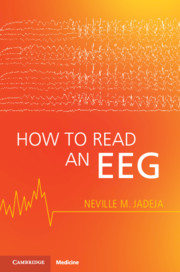Book contents
- How to Read an EEG
- How to Read an EEG
- Copyright page
- Dedication
- Contents
- Figure Contributions
- Foreword
- Preface
- How to Read This Book
- Part I Basics
- Chapter 1 Introduction
- Chapter 2 Polarity
- Chapter 3 Montages
- Chapter 4 Localization
- Chapter 5 Active Reference
- Chapter 6 Frequencies and Rhythms
- Chapter 7 Maturation
- Chapter 8 Normal Adult EEG
- Part II Interpretation
- Part III Specific Conditions
- Appendix How to Write a Report
- Index
- References
Chapter 3 - Montages
from Part I - Basics
Published online by Cambridge University Press: 24 June 2021
- How to Read an EEG
- How to Read an EEG
- Copyright page
- Dedication
- Contents
- Figure Contributions
- Foreword
- Preface
- How to Read This Book
- Part I Basics
- Chapter 1 Introduction
- Chapter 2 Polarity
- Chapter 3 Montages
- Chapter 4 Localization
- Chapter 5 Active Reference
- Chapter 6 Frequencies and Rhythms
- Chapter 7 Maturation
- Chapter 8 Normal Adult EEG
- Part II Interpretation
- Part III Specific Conditions
- Appendix How to Write a Report
- Index
- References
Summary
Montages are specific arrangements of channels; a channel is a pair of electrodes. Waveforms result from cerebral potentials; each montage allows the reader to appreciate the same waveform through a distinct point of view. Bipolar montages consist of channels with adjacent electrode pairs. Referential montages consist of channels with nonadjacent electrode pairs. One electrode is located closer to the cerebral activity (active), while the other is intended as a distant reference (inactive). Common bipolar montages include the longitudinal bipolar (double banana) and transverse bipolar. Common referential montages include contralateral and ipsilateral ear reference, central reference (vertex), or average reference. Bipolar montages are less prone to artifact and best appreciate focal potentials. Referential montages are more prone to artifact and best appreciate broad or generalized potentials. An active reference results when the reference which is intended to be neutral is very active. The reader must use both types of montages to evaluate the same waveform. Digital displays make it easy to switch between montages.
Keywords
- Type
- Chapter
- Information
- How to Read an EEG , pp. 17 - 22Publisher: Cambridge University PressPrint publication year: 2021

